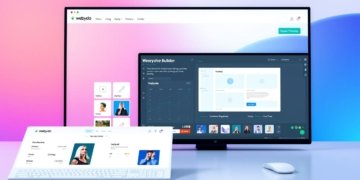What if you could create and sell online courses with ease, reaching a vast audience and generating significant revenue? With Teachable, an online course platform, you can turn your expertise into a profitable business. As the e-learning market is projected to reach $375 billion by 2026, the potential for growth is immense. Teachable, as an e-learning platform, provides the tools and features to help you succeed.
Using Teachable, you can design and launch your course, leveraging its AI-powered course creation tools to transform your existing content into a polished online course in just three days. But, how can you maximize your chances of success on this online course platform? By understanding the key elements of creating and marketing a successful online course, you can increase your conversion rates and reach your target audience more effectively.
Introduction to Mastering Teachable
Teachable is more than just an online course platform – it’s a comprehensive solution for creating, marketing, and selling online courses. With its user-friendly interface and robust features, Teachable makes it easy to get started and achieve your goals. Whether you’re a seasoned educator or an entrepreneur looking to share your knowledge, Teachable provides the tools and support you need to succeed.
Key Takeaways
- Teachable is an online course platform that helps you create and sell online courses with ease
- The e-learning market is projected to reach $375 billion by 2026, offering immense growth potential
- Teachable’s AI-powered course creation tools can help you transform your existing content into a polished online course in just three days
- Understanding your target audience and creating a well-structured course is crucial for success on the Teachable platform
- Effective marketing and promotion strategies can help you increase conversion rates and reach your revenue goals
- Utilizing Teachable’s features and tools can help you streamline your course creation and sales process
- Building a membership community and leveraging advanced analytics can help you optimize your sales strategies and achieve long-term success
Introduction to Teachable
Teachable is a digital education platform that enables users to create and sell online courses, making it easier to teach online. With its comprehensive course creation tool, users can design and deliver high-quality courses to their students. The platform provides a range of features, including course creation tools, payment processing, and marketing automation, making it an ideal choice for anyone looking to create and sell online courses.
What is Teachable?
Teachable is an all-in-one platform that allows users to create a professional-looking course website, upload their course content, and start selling their Verm online courses. The platform is designed to be user-friendly, making it easy for anyone to get started with creating and selling online courses, even those with no prior experience in digital education.
Key Features of Teachable
Teachable offers a range of key features that make it an ideal choice for creating and selling online courses. These features include course creation tools, payment processing, and marketing automation, all of which are designed to help users create and sell successful online courses. With Teachable, users can create a professional-looking course website, upload their course content, and start selling their courses, all from one easy-to-use platform.
Who Can Benefit from Teachable?
Anyone can benefit from using Teachable, from individual instructors to large organizations. The platform is designed to be flexible and scalable, making it easy for users to create and sell online courses, regardless of their level of experience or the size of their organization. With Teachable, users can teach online and reach a wider audience, making it an ideal choice for anyone looking to create and sell online courses.
Setting Up Your Teachable Account
To start creating online courses with the teachable app, you need to set up your account. This process is straightforward and requires minimal information. You can sign up for a free Teachable plan, which gives you access to all the tools you need to create your course.
Creating an Account
First, you need to provide your email address and password to create an account. This will be your login credentials, so make sure to choose a strong password. Once you’ve created your account, you can proceed to choose a plan that suits your needs.
Choosing Your Plan
Teachable offers a range of plans, from free to paid, each with its own set of features. The free plan is a great way to get started, as it allows you to create online courses and sell them to your students. As you grow, you can upgrade to a paid plan to access more features and support.
Navigating the Dashboard
Once you’ve chosen your plan, you can navigate the dashboard to start creating your course. The dashboard provides an overview of your account, including your courses, students, and sales. You can use the teachable app to create and manage your courses, as well as track your progress and analytics.
Designing Your Course
When creating a successful online course, it’s essential to start with a well-structured plan. This involves identifying your course topic and defining your target audience. According to experts, a course outline contains the building blocks of your online course, including the overall learning objectives and module breakdown. On an online course platform like Teachable, you can easily create a professional-looking course website and upload your course content.
Identifying Your Course Topic
To design a successful online course, you need to choose a topic that resonates with your target audience. Consider what problems your audience is trying to solve and what knowledge or skills they want to acquire. With an e-learning platform like Teachable, you can create a course that addresses these needs and provides valuable learning experiences.
Structuring Course Content
Once you have identified your course topic, it’s time to structure your course content. Break down your course into modules and lessons, and create a logical flow of learning objectives. Teachable’s course builder makes it easy to create a well-structured course that engages your students and helps them achieve their learning goals.
By following these steps and using an online course platform like Teachable, you can create a successful online course that attracts and retains students. With the right design and structure, your course can become a valuable resource for learners and a profitable venture for you.
Course Pricing and Payment Setup
When creating a course to teach online, determining your pricing and enrollment strategy is crucial before launching your course. This step is vital as it directly affects your revenue and the overall success of your course. Using a course creation tool like Teachable makes it easy to set up payment processing and manage your course sales.
Teachable offers various plans, including Basic, Pro, and Pro+, each with its own set of features and pricing. The Basic Plan costs $59/month, with a 5% transaction fee, while the Pro Plan costs $159/month with no transaction fee. The Pro+ Plan costs $249/month, also with no transaction fee. Understanding these plans and their associated costs is essential to setting up your course pricing and payment setup.
Setting Course Prices
Setting the right course price is critical to attracting students and generating revenue. You should consider the value your course provides, the target audience, and the competition when determining your course price. Teachable allows you to set your course price and manage payment plans, making it easy to teach online and reach a wide audience.
Managing Payment Plans
Teachable’s payment plans are flexible, allowing you to offer one-time payments, subscriptions, or payment plans. You can also set up recurring payments and manage refunds. Understanding the payment plans and transaction fees associated with each plan is essential to managing your course sales and revenue.
Understanding Transaction Fees
Transaction fees are an important consideration when setting up your course pricing and payment setup. Teachable’s transaction fees vary depending on the plan you choose, with the Basic Plan having a 5% transaction fee and the Pro and Pro+ Plans having no transaction fee. Additionally, there are processing fees for credit and debit card sales, as well as PayPal sales. Understanding these fees is crucial to managing your revenue and ensuring you’re getting the most out of your course sales.
Adding Course Content
To create a successful online course on a digital education platform, it’s essential to add engaging and informative content. This can include videos, resources, quizzes, and assignments. When creating online courses, consider incorporating visuals, such as infographics or icons, to break up text and make the information more engaging and easier to digest.
Uploading Videos and Resources
Teachable’s course builder makes it easy to upload and manage your course content. You can upload videos with a recommended resolution of 720p and frames per second between 24-30. The supported video file size limit is 2GB or smaller. Additionally, you can upload audio files in .mp3 format and images with a recommended resolution of 1000px wide or smaller.
Creating Quizzes and Assignments
Quizzes and assignments are great ways to engage students and assess their understanding of the course material. On Teachable, you can create quizzes with features like enforcing lesson order and requiring a minimum passing score for progression. You can also customize completion certificates with elements like your logo, title, and colors.
By using a digital education platform to create online courses, you can reach a wider audience and provide a comprehensive learning experience. With the right content and features, you can increase engagement rates and help your students achieve their goals.
Engaging with Your Students
Engaging with students is crucial for the success of an online course. The teachable app provides various tools to facilitate interaction, making it an excellent online course platform. By utilizing these tools, instructors can create a supportive learning environment that fosters student success.
Communication Tools in Teachable
The teachable app offers communication tools that enable instructors to connect with students, share resources, and provide feedback. This helps build a sense of community, which is essential for student engagement and motivation. As an online course platform, teachable app provides features that support interactive learning, making it easier for instructors to engage with their students.
Creating Community Forums
Community forums are an excellent way to encourage student interaction and discussion. By creating a space for students to share their thoughts and ideas, instructors can promote collaborative learning and increase student engagement. The teachable app makes it easy to set up community forums, allowing instructors to focus on what matters most – teaching and supporting their students.
Offering Feedback and Support
Providing feedback and support is vital for student success. The teachable app enables instructors to offer personalized feedback, helping students stay on track and achieve their goals. By leveraging the teachable app’s features, instructors can create a supportive learning environment that encourages students to engage with the course material and succeed in their online learning journey.
Marketing Your Course
As an educator on an e-learning platform, marketing your course is crucial to attract potential learners and increase enrollment. To effectively market your course, you need to identify your unique selling proposition (USP) and articulate the transition students can expect after completing the course. This will help you differentiate yourself from other educators and highlight the intrinsic value of your course.
Utilizing email marketing and integrating social media promotions can also help increase visibility and reach a broader audience. With over 41 defined strategies for effectively marketing online courses, it’s essential to focus on the most effective methods, such as building a sales page, utilizing keyword research, and leveraging video content on platforms like YouTube. By teaching online and using an e-learning platform like Teachable, you can create a dedicated sales page outlining course details, duration, and learning outcomes to instill confidence in potential buyers.
Building a Sales Page
A well-designed sales page can make all the difference in attracting and persuading potential learners to enroll in your courses. By including student testimonials, course reviews, and a clear outline of the course content, you can establish credibility and trust with potential students. Additionally, utilizing platforms like Instagram, Facebook, and Pinterest to promote your course can enhance visibility and increase potential sales.
Utilizing Email Marketing
Email marketing is a powerful tool for reaching your target audience and promoting your course. By building a warm email list and crafting personalized pitches, you can increase the likelihood of successful launches and create a loyal following. With the potential customer base for a specific niche market being approximately 10,000 potential customers every year, it’s essential to focus on effective marketing strategies to reach and engage with your target audience.
Analyzing Course Performance
To create online courses that resonate with students, it’s essential to analyze course performance on a digital education platform. This involves tracking enrollment metrics, such as the number of students enrolled, completion rates, and revenue per student. By monitoring these metrics, instructors can identify areas for improvement and make data-driven decisions to optimize their courses.
Tracking Enrollment Metrics
Enrollment metrics provide valuable insights into the effectiveness of a course. Instructors can use this data to identify trends and patterns, such as seasonal fluctuations in enrollment or demographics of their target audience. By analyzing this data, instructors can refine their marketing strategies and create more engaging content to attract and retain students.
Using Feedback for Improvement
Feedback from students is a crucial component of course improvement. Instructors can use feedback to identify areas where students are struggling and make adjustments to the course content or structure. By incorporating feedback into the course development process, instructors can create a more effective and engaging learning experience, ultimately leading to higher student satisfaction and better outcomes on a digital education platform.
Advanced Features of Teachable
As you continue to grow your online course, you may want to explore the advanced features of the teachable app. One way to enhance the functionality of your online course platform is by integrating third-party tools. According to recent data, integrating these tools can significantly improve the overall user experience.
Integrating Third-Party Tools
The teachable app allows you to integrate various third-party tools to enhance the functionality of your online course platform. This can include tools for email marketing, analytics, and sales processes. By leveraging these integrations, you can create a more comprehensive and engaging experience for your students.
Using Affiliates to Expand Reach
Another advanced feature of the teachable app is the ability to use affiliates to expand your reach. This can help you promote your online course to a wider audience and increase your earnings. By partnering with affiliates, you can create a network of promoters who can help spread the word about your online course platform.
Customizing User Experience
Finally, the teachable app allows you to customize the user experience of your online course platform. This can include creating a professional-looking course website, customizing the layout and design, and adding your own branding. By customizing the user experience, you can create a unique and engaging environment for your students to learn and grow.
Troubleshooting Common Issues
When using an e-learning platform like Teachable to teach online, it’s essential to be aware of common issues that may arise and know how to troubleshoot them. Teachable provides technical support resources to help you resolve any problems that may occur. One common issue is customers not getting added to a course upon order completion. This is often due to being on a free or basic Teachable plan, which does not support third-party integrations.
To avoid this issue, ensure you have a Pro plan or higher and that your Teachable password is up-to-date. If you’ve changed your password after setting up the integration, you’ll need to update it in your third-party integration tool, such as ThriveCart. Additionally, make sure to use “https://” in your Teachable URL to enable communication with your integration tool.
Common Setup Problems
Common setup problems can be avoided by carefully configuring your integration. For example, when using ThriveCart, you’ll need to add specific school names for clarity in selecting the corresponding Teachable site. You’ll also need to create and publish your Teachable course before it can be selected for integration.
Technical Support Resources
Teachable’s technical support resources are available to help you troubleshoot any issues that may arise. You can also refer to FAQs for new instructors, which provide guidance on common problems and solutions. By being aware of these resources and taking steps to avoid common issues, you can ensure a smooth experience when teaching online using an e-learning platform like Teachable.
Conclusion and Next Steps
As you’ve discovered throughout this comprehensive guide, Teachable is a powerful platform that empowers you to create and share your online courses with the world. You’ve learned the essential steps to set up your account, design engaging course content, and effectively market your offerings.
Recapping Key Takeaways
Remember the key takeaways from this journey: Utilize Teachable’s intuitive course builder to structure your lessons, leverage its communication tools to foster student engagement, and analyze your course performance to continually improve. With Teachable, you have the necessary resources to transform your expertise into a successful online
create online courses
business.
Encouragement to Start Teaching
Now that you’ve mastered the fundamentals of Teachable, it’s time to put your knowledge into action. Don’t hesitate to start creating your first course or to expand your existing
digital education platform
offerings. The potential for growth and impact is limitless when you leverage the power of this dynamic platform.
Resources for Further Learning
As you embark on your Teachable journey, continue exploring the platform’s features, engaging with the community, and seeking out additional resources to enhance your skills. The Teachable support documentation, webinars, and user forums are valuable sources of information to help you navigate your way to online course success.
Remember, the road to creating a thriving online education business is paved with dedication, creativity, and a willingness to learn. Embrace the Teachable platform, and let your passion for teaching guide you to new heights. Wishing you all the best in your endeavors!
FAQ
What is Teachable?
What are the key features of Teachable?
Teachable’s key features include course creation tools, payment processing, and marketing automation.
Who can benefit from using Teachable?
Anyone can benefit from using Teachable, from individual instructors to large organizations.
How do I set up a Teachable account?
Setting up your Teachable account is a straightforward process. First, you need to create an account by providing your email address and password. Next, you need to choose a plan that suits your needs.
How do I design my online course?
Designing your course is a critical step in creating a successful online course. First, you need to identify your course topic and define your target audience. Next, you need to structure your course content into modules and lessons. Teachable’s course builder makes it easy to create a professional-looking course website and upload your course content.
How do I set up my course pricing and payment?
Setting up your course pricing and payment setup is an important step in launching your course. You need to determine your course prices, manage payment plans, and understand transaction fees. Teachable makes it easy to set up payment processing and manage your course sales.
How do I add content to my online course?
Adding course content is a critical step in creating a successful online course. You can upload videos, resources, quizzes, and assignments to create an engaging learning experience. Teachable’s course builder makes it easy to upload and manage your course content.
How do I engage with my students?
Engaging with your students is an important step in creating a successful online course. You can use Teachable’s communication tools to connect with your students, create community forums to facilitate discussion, and offer feedback and support to help your students succeed.
How do I market my online course?
Marketing your course is a critical step in launching a successful online course. You can build a sales page to showcase your course, utilize email marketing to reach your target audience, and integrate social media promotions to increase visibility.
How do I analyze my course performance?
Analyzing course performance is an important step in creating a successful online course. You can track enrollment metrics, analyze student progress, and use feedback to improve your course. Teachable provides analytics tools to help you track your course performance.
What advanced features does Teachable offer?
Teachable’s advanced features can help you take your online course to the next level. You can integrate third-party tools to enhance functionality, use affiliates to expand your reach, and customize the user experience to create a professional-looking course website.
Where can I find help with troubleshooting common issues?
Troubleshooting common issues is an important step in creating a successful online course. You can refer to Teachable’s technical support resources, FAQs for new instructors, and common setup problems to resolve any issues that may arise.










